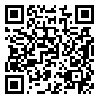Volume 11, Issue 44 (2018)
LCQ 2018, 11(44): 29-50 |
Back to browse issues page
1- Faculty of shiraz university
2- student of shiraz university , n.za515@yahoo.com
2- student of shiraz university , n.za515@yahoo.com
Abstract: (9237 Views)
One of the important measutres in exploring the evolution of literary criticism in Iran is the review of critical works with the aim of identifying their stregths and weaknesses along with quality evaluation. Given the need for such an attitude in the realm of literary research, the authors resolved to evaluate the critical approach assumed by Mohammad Hoghoogi, one of the most renowned pioneers of New criticism in Iran. Hence, his critical works have been studied using content analysis and descriptive-analytical approaches and their characteristics have been explained. According to the finding, Hoghooghi is mostly concentrated on formal features and morphology of literary work and his critiques are majorly structured on three principles, namely language and diction, settings and idea, and form and structure which are commonly referred to as Hoghooghis critique traingle. Such formalistic propensity along with his interest to structure have led some of his interpretations to become roughly superficial or enthusiastic, and though approximating modern and scientific criticism, his critiques go to ex tremes in some cases and fail to demonstrate the true value of literary work.
Keywords: Mohammad Hoghooghi, literary criticism, language and diction, setting and idea, form and structure
Article Type: Analytic Review |
Subject:
Street literature
Received: 2019/01/16 | Accepted: 2019/04/30 | Published: 2018/05/15
Received: 2019/01/16 | Accepted: 2019/04/30 | Published: 2018/05/15
| Rights and permissions | |
 |
This work is licensed under a Creative Commons Attribution-NonCommercial 4.0 International License. |



